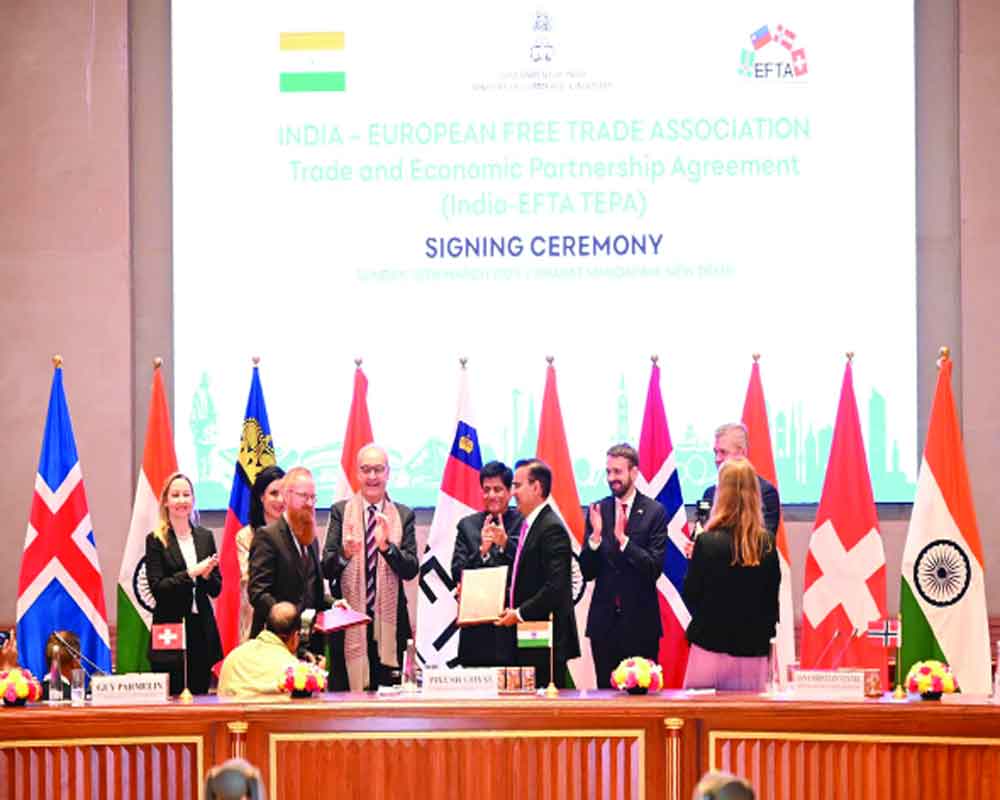Trade and Economic Partnership Agreement is a game changer
India signing a low-hanging trade agreement with four European countries, earlier this week, marks a new chapter in the policy outlook going forward. For starters the Trade and Economic Partnership Agreement (TEPA), India managed to close with European Free Trade Association ( EFTA) member countries (comprising of Switzerland, Iceland, Norway and Liechtenstein) is a first of its kind with developed countries from the Western world.
It would be worth mentioning that India has been trying to sign trade agreements (FTAs) with the Western world, particularly the larger European Union, the UK and in the long run with the US for several years. However, all of these negotiations, which tend to get extremely complex, when dealing with Western nations, due to divergences in priorities, failed to fructify into something meaningful, in decades. India’s external economic policy outlook, for a very long, including the early years of PM Narendra Modi’s government, prioritised the domestic sector, over a more integrated new world trade-based economy. This had also raised concerns about the current government’s priorities being too protectionist, which in plain English meant providing artificial government shield to, often, inefficient domestic manufacturing, leading to high-cost, low-quality products and services for the domestic market.
India had also walked out of the Regional Comprehensive Economic Partnership agreement (one of the largest multilateral trade agreements among ASEAN members and Australia, China, Japan, South Korea etc) after multiple rounds of negotiations, citing a disproportionate advantage to China in the agreement. This left little room for the Indian economy to grow and get more investments, create fresh employment and provide the necessary fillip to exports, however, things began to change during the second term of PM Modi beginning in 2019.
At a time when the global chorus started shifting to being more pro-protectionist, i.e. trying to save their domestic industry, as a result of the Covid Pandemic, the Ukraine war and tensions in West Asia, India managed to sign two early harvest trade agreements with UAE and Australia in record time. This was a signal to the world that India is willing to negotiate at the trade table (being the fifth largest economy serves as a good bait) and get further integrated with the global economy, of course, on terms that are mutually beneficial for all participating partners. India is currently in deep negotiations with the UK for signing an FTA, whose final signing was being tuned up as another feather in the current government’s economic successes, however, it will have to wait longer for eco-political reasons.
The UAE trade agreement had also opened doors for India to negotiate a similar deal with the Gulf Cooperation Council (where UAE is also an influential member) but the West Asian crisis may delay the negotiations. It may be mentioned here, that, the Oman FTA has a definite stellar output record from the commerce ministry. Coming back to the TEPA, commerce minister Piyush Goyal during the announcement underscored “The agreement will give a boost to Make in India and provide opportunities to young & talented workforce. The FTA will provide a window to Indian exporters to access large European and global markets.”
TEPA heavily relies on a nearly $100 billion investment commitment from the EFTA members in a fifteen-year window, which could serve as an important benchmark and a template for signing similar deals with other developed nations. India and the EU have taken several steps to arrive at some sort of a free trade agreement, albeit, negotiating with 27 member countries’ union may be slightly more complex. The message from India, which has tasted high growth years, despite several setbacks from global headwinds, is clear, the domestic market is open for business and Indian exporters are confident to win the world.
(The writer is a policy analyst; views are personal)


























